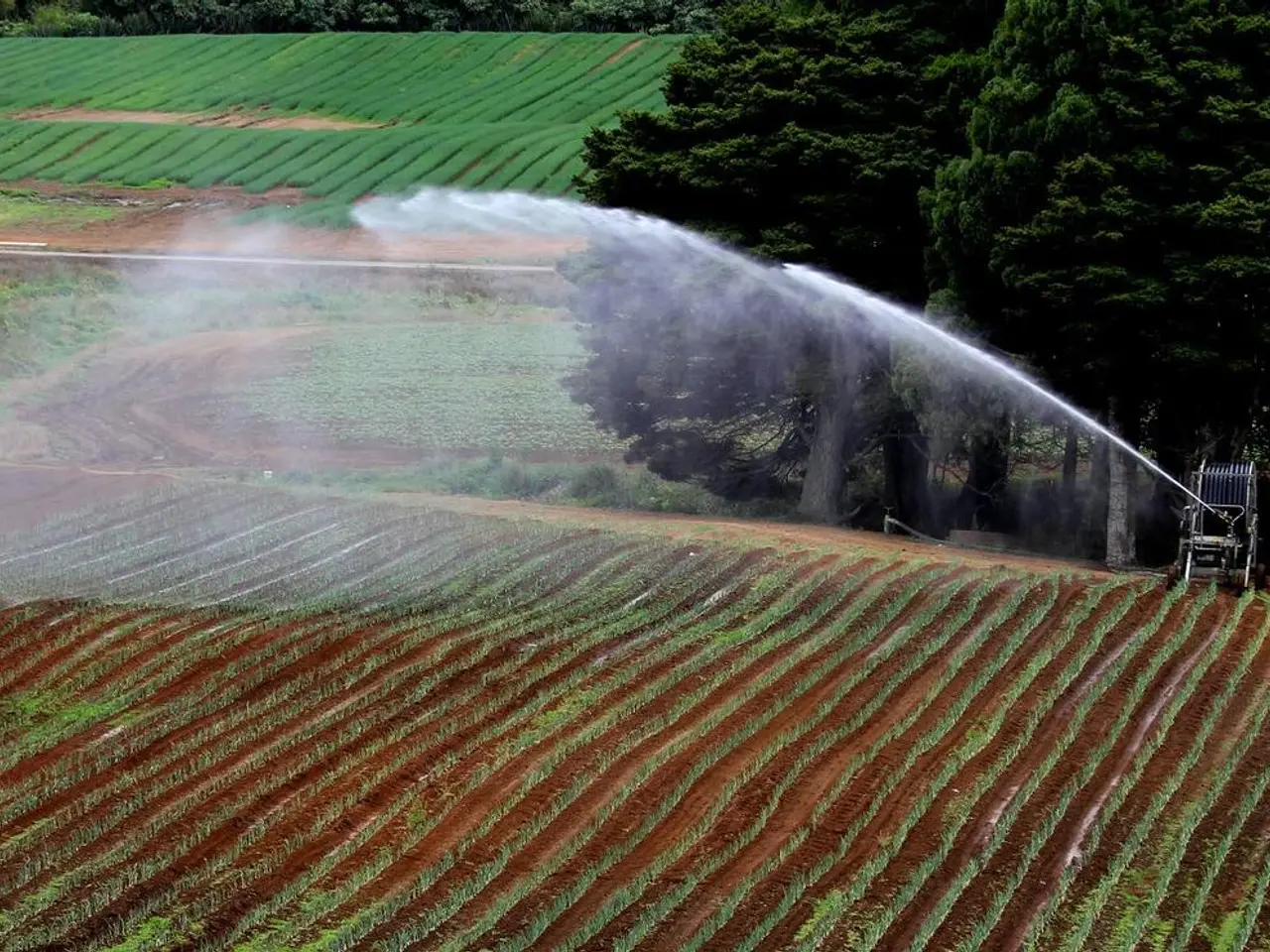Regulating Excessive Groundwater Levels: Strategies for Water Table Maintenance
In the agricultural sector, efficient water table management is crucial for maintaining water security and ensuring sustainable farming practices. Inefficient use of water resources and increased water waste, often due to over-irrigation, can have detrimental effects on both the environment and crop yields.
To address these issues, a combination of sustainable farming methods, advanced irrigation technologies, digital tools, and integrated water resource management (IWRM) is key.
Sustainable Farming Practices
Techniques like crop rotation, cover cropping, mulching, and minimum tillage improve soil health and water retention, reducing runoff and erosion that can negatively affect the water table. These practices help maintain soil organic matter, enhancing infiltration and moisture retention around root zones.
Efficient Irrigation Technologies
Drip irrigation delivers water directly to plant roots, minimizing evaporation and surface runoff compared to overhead sprinklers. Precision irrigation methods, often powered by smart systems, match water supply to crop needs, avoiding over-irrigation which can raise the water table excessively or cause leaching.
Digital and AI Technologies
The use of IoT sensors (soil moisture, weather), satellite remote sensing, drones, AI, and big data analytics enables real-time monitoring and precise control of irrigation. AI-driven irrigation platforms optimize scheduling and water volumes to maximize efficiency, reducing unnecessary water application that influences the water table.
Buffer Zones and Vegetative Strips
Establishing vegetated buffer zones along watercourses traps sediments and absorbs excess nutrients and chemicals before they reach groundwater or surface water, protecting water quality and preventing contamination of the water table.
Integrated Water Resource Management (IWRM)
Managing water use at the watershed or basin scale ensures sustainable balancing of supply and demand across agricultural, urban, and environmental needs. IWRM protects aquifers and surface water features by preventing over-abstraction and promoting stakeholder collaboration, critical for maintaining stable water tables.
Crop Selection and Soil Management
Choosing drought-tolerant or water-efficient crops suited to local conditions reduces irrigation demand and water table stress. Improving soil structure with organic matter helps soil retain more water, reducing irrigation frequency and runoff impacts.
To mitigate over-irrigation, strategies such as crop rotation and diversification, cover crops for soil management, and appropriate soil amendments can be employed.
Future trends in water management include the adoption of new irrigation technology, like sensors and AI systems, and adapting to climate change. The use of cover crops is a great way to manage soil and cut down on over-irrigation, as no-till farming can save up to 12 extra inches of water compared to tilled fields.
Resources for farmers include educational programs, financial aid, and advice from government and non-profits to help them save water and use it better. Compliance with environmental standards is essential for keeping water safe and protecting water sources.
Engaging the local community is essential for the widespread adoption of water-saving practices in agriculture. Implementing water budgets and conducting regular irrigation system audits can improve water efficiency.
Inefficient water management can lead to groundwater depletion and reduced recharge rates. Keeping groundwater resources healthy is key for ensuring water security for the future. The cost of irrigation and water saving is now a significant consideration due to water scarcity worldwide.
Proper training in irrigation system installation, maintenance, and management is crucial. The decline in gravity-flow irrigation systems since 1979 is 20%. Climate change is a big threat to water availability and requires adaptable water management. Decentralized systems, like on-site treatment, can help with sustainable water management.
The final rule for the Produce Safety Rule aims to enhance public health protections, accommodate different agricultural water systems, and integrate advancements in agricultural water quality science. The cost-benefit analysis of efficient practices is vital for studying the long-term gains of water conservation practices.
Sustainable water management is crucial for the future and includes using new technologies, making water use more efficient, and reusing wastewater. Irrigation as a percentage of freshwater consumption in Western States is 90%.
In conclusion, efficient management of the water table in agriculture hinges on reducing water waste through sustainable soil and crop management, precision irrigation using digital and AI technologies, protecting water bodies with buffer zones, and applying a holistic watershed-level approach via IWRM. These approaches collectively sustain groundwater levels, minimize pollution risks, and enhance resilience to climatic variability.
- Sustainable farming methods, such as crop rotation, cover cropping, mulching, and no-till, contribute to soil health, water retention, and better water table management.
- Drip irrigation and precision irrigation methods are efficient ways to minimize water waste, reduce over-irrigation, and optimize water use in line with crop needs.
- AI-driven irrigation platforms and IoT sensors can provide real-time monitoring and analysis, encouraging more efficient water use and healthier soil management.
- Buffer zones and vegetative strips can filter excess nutrients, chemicals, and sediments, protecting water sources and maintaining a stable water table.
- Integrated Water Resource Management (IWRM) promotes water conservation across different sectors and geographical scales, ensuring sustainable water use for future generations.
- Crop selection, soil management, and strategies like crop rotation, cover crops, and appropriate soil amendments can reduce irrigation demands and mitigate the impact of climate change on the water table.




